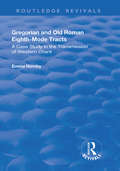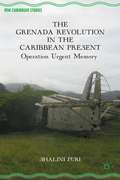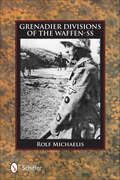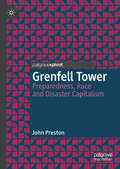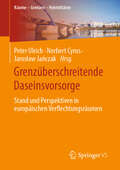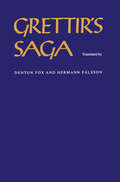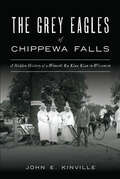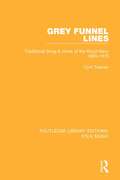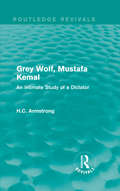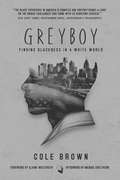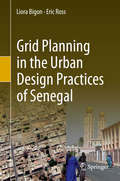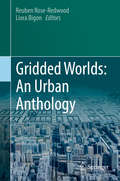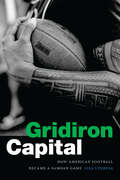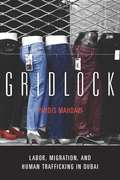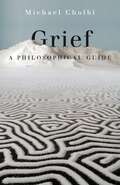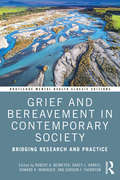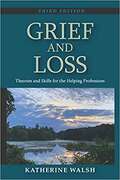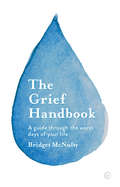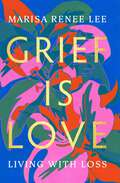- Table View
- List View
Gregorian and Old Roman Eighth-mode Tracts: A Case Study in the Transmission of Western Chant (Routledge Revivals)
by Emma HornbyThis title was first published in 2002: This text uses detailed analysis of the eigth-mode tracts in addressing some of the still unresolved questions of chant scholarship. The first question is that of the nature of the relationship between Old Roman and Gregorian chant, the second, of the relationship between oral and written modes of transmission in the ecclesiastical culture of the Middle Ages. Also, the Middle Ages saw a transition to a culture more dependent on writing. The book investigates the effect this transition had on the way eighth-mode tracts were understood by those who performed and notated them.
Gregory Bateson on Relational Communication: From Octopuses to Nations (Biosemiotics #20)
by Phillip GuddemiThis book develops Gregory Bateson’s ideas regarding “communication about relationship” in animals and human beings, and even nations. It bases itself on Bateson’s theory of relational communication, as he described it in the zoosemiotics of octopus, mammals, birds, and human beings. This theory includes, for example, the roles of metaphor, play, analog and digital communication, metacommunication, and Laws of Form. It is organized around a letter from Gregory Bateson to his fellow cybernetic thinker Warren McCulloch at the time of the Cuban Missile Crisis. In this letter Bateson argued that what we would today call zoosemiotics, including Bateson’s own (previously unpublished) octopus research, should be made a basis for understanding the relationship between the two blocs of the Cold War. Accordingly the book shows how Bateson understood interactive processes in the biosemiotics of conflict and peacemaking, which are analyzed using examples from recent animal studies, from primate studies, and from cultural anthropology. The Missile Crisis itself is described in terms of Bateson’s critique of game theory which he felt should be modified by an understanding of the zoosemiotics of relational communication. The book also includes a previously unpublished piece by Gregory Bateson on wolf behavior and metaphor/ abduction.
The Grenada Revolution in the Caribbean Present
by Shalini PuriThe Grenada Revolution in the Caribbean Present: Operation Urgent Memory is the first scholarly book from the humanities on the subject of the Grenada Revolution and the US intervention. It is simultaneously a critique, tribute, and memorial. It argues that in both its making and its fall, the 1979-1983 Revolution was a transnational event that deeply impacted politics and culture across the Caribbean and its diaspora during its life and in the decades since its fall. Drawing together studies of landscape, memorials, literature, music, painting, photographs, film and TV, cartoons, memorabilia traded on e-bay, interviews, everyday life, and government, journalistic, and scholarly accounts, the book assembles and analyzes an archive of divergent memories. In an analysis that is relevant to all micro-states, the book reflects on how Grenada's small size shapes memory, political and poetic practice, and efforts at reconciliation.
Grenadier Divisions of the Waffen-SS
by Rolf MichaelisConcise history of all 18 Waffen-SS grenadier divisions in WWII
Grenfell Tower: Preparedness, Race and Disaster Capitalism
by John PrestonThe Grenfell Tower fire of June 2017 is one of the most tragic political events in British history. This book argues that preparedness for disasters has always been designed in the interests of the State and Capital rather than citizens. This was exemplified by the ‘stay put’ strategy at Grenfell Tower which has historically been used to socially control racialised working class groups in a disaster. ‘Stay put’, where fire safety is compromised along with strategic ambiguity, probabilistically eliminates these groups. Grenfell Tower is a purposive part of ‘Disaster Capitalism’, an asocial racial and class eliminationism, where populations have become unvalorisable and disposable. We have reached a point where even the ruling class are fleeing from the disasters and chaos they have inflicted on the world, retreating to their billionaire bunkers. This timely book will be of interest to sociologists, social theorists and activists in understanding the racialised, classed and capitalist nature of contemporary disasters.
Grenzen, Entgrenzung und Grenzüberschreitungen der Public Relations und Organisationskommunikation
by Thomas Koch Johannes Beckert Benno Viererbl Nora DennerDer insbesondere durch die Digitalisierung ausgelöste Medienwandel und die daraus erwachsenen Veränderungsprozesse für die Public Relations und Organisationskommunikation führ(t)en zum Verschwimmen zahlreicher Grenzen, die früher deutlicher zu erkennen waren. Der vorliegende Sammelband nimmt in drei Themenblöcken diese Grenzverschiebungen und die daraus resultierenden Veränderungsprozesse in den Blick. Erstens wird die Entgrenzung des Berufsfelds der PR und Organisationskommunikation betrachtet, wobei insbesondere die Vermischung von Journalismus und strategischer Kommunikation im Fokus steht. Zweitens fokussiert der Band die Entgrenzung spezifischer Bereiche und Instrumente der strategischen Kommunikation (z.B. Wahlkampfkommunikation, Markt- und Markenkommunikation, Beteiligungsverfahren). Drittens gehen Beiträge in dem Band Fragen nach ethisch-normativen Grenzverschiebungen und -überschreitungen in der strategischen Kommunikation nach und diskutieren, wie diese neu verhandelt werden.
Grenzmanagement im Wandel: Transnationale Bedrohungen und Sicherheitspolitik der europäischen Staaten
by Johann WagnerDieses Buch befasst sich mit den Prozessen des Wandels und der Erneuerung der Grenzkontrollen und der Grenzsicherung und -verwaltung in den letzten 30 Jahren nach dem Fall des Eisernen Vorhangs sowie mit den immensen Herausforderungen bei der Nationenbildung in Südosteuropa nach dem Zusammenbruch des ehemaligen Jugoslawien in Bezug auf das strategische Sicherheitsmanagement. Die Abschaffung der Grenzkontrollen im Schengen-Raum und die gleichzeitige Einführung notwendiger Ersatzmaßnahmen war ein weiteres Thema.Das Buch gibt einen Einblick in die Kompetenzen der Europäischen Union bei der Reform und Modernisierung der staatlichen Strafverfolgungsbehörden zur Gewährleistung einer effektiven Grenzkontrolle, Grenzüberwachung und Grenzverwaltung im Einklang mit dem EU-Besitzstand und den EU-Standards.Im 21. Jahrhundert schafft ein sich ständig weiterentwickelndes Sicherheitsumfeld zusammen mit dem Prozess der Globalisierung neue Dimensionen von Bedrohungen und Herausforderungen für die Sicherheit und Stabilität transnationaler Natur. Dies erfordert umfassende, multidimensionale, kollektive und gut koordinierte Antworten.Die Europäische Union, die Organisation für Sicherheit und Zusammenarbeit in Europa (OSZE), die Vereinten Nationen sowie andere internationale Organisationen sind in der Lage, einen echten Beitrag zur Entwicklung kooperativer und koordinierter Antworten auf diese Bedrohungen zu leisten, indem sie sich auf ihre breite Mitgliedschaft und ihr profundes Fachwissen und ihre Erfahrung stützen.Nach Auffassung der Europäischen Union sollte ein modernes, kosten- und nutzenorientiertes und effektives Grenzschutzsystem sowohl offene Grenzen als auch ein Höchstmaß an Sicherheit gewährleisten. Daher ist die Union bestrebt, die innere Sicherheit aller Mitgliedstaaten durch die Verhinderung grenzüberschreitender Bedrohungen, die Bekämpfung der irregulären Migration und jeglicher Form der grenzüberschreitenden Kriminalität zu gewährleisten, um einen reibungslosen Grenzübertritt für legitime Reisende und deren Hab und Gut, Waren und Dienstleistungen sicherzustellen.Aus diesem Grund wurde das Unionskonzept des integrierten Grenzschutzes entwickelt, um eine wirksame Grenzkontrolle und -überwachung sowie eine kosteneffiziente Verwaltung der Außengrenzen der Europäischen Union zu gewährleisten.Die Politik der Union wird auch in Zukunft auf der Grundlage der drei wichtigsten Bereiche entwickelt: gemeinsame Rechtsvorschriften, enge operative/taktische Zusammenarbeit und finanzielle Solidarität. Darüber hinaus wurde die integrierte Grenzverwaltung als vorrangiger Bereich für die Stärkung der Zusammenarbeit mit Drittländern im Rahmen des strategischen Sicherheitsmanagementkonzepts der Europäischen Kommission bestätigt, in dem Nicht-EU-Länder als Partner ermutigt werden, ihre Grenzsicherheits-, Überwachungs- und Grenzverwaltungssysteme zu verbessern.
Grenzüberschreitende Daseinsvorsorge: Stand und Perspektiven in europäischen Verflechtungsräumen (Räume – Grenzen – Hybriditäten)
by Peter Ulrich Norbert Cyrus Jarosław JańczakGrenzüberschreitende Verbindungen werden in der Europäischen Union dichter und intensiver. Die national organisierten und ausgerichteten Angebote der öffentlichen Daseinsvorsorge kommen an ihre Grenzen. Der Band führt in das innovative Konzept der grenzüberschreitenden Daseinsvorsorge ein und bietet eine theoretisch fundierte Grundlage für die Analyse von Stand und Entwicklungsperspektiven grenzüberschreitender Angebote der Daseinsvorsorge. Das Buch versammelt Beiträge mit konzeptionellen Überlegungen sowie empirischen Analysen der Praxis grenzüberschreitender Kooperationen in den Daseinsvorsorgebereichen Mobilität, Gesundheit, Bildung, Katastrophenschutz, Energiekooperation, Wärmeversorgung, Raumplanung und Grenzmobilitätsberatung. Die transdisziplinäre Ausrichtung des Bandes befördert den intra- und interregionalen Dialog zur Gestaltung grenzüberschreitender Daseinsvorsorge und bietet Impulse für Lern- und Transferprozesse in und zwischen europäischen Verflechtungsräumen.
Grenzüberschreitender Tourismus in Schutzgebieten: Potenziale, Fallstricke und Perspektiven
by Marius Mayer Wojciech Zbaraszewski Dariusz Pieńkowski Gabriel Gach Johanna GernertDieses Buch erörtert, wie der Tourismus zwischen Nachbarländern wie Polen und Deutschland trotz des Schengener Abkommens behindert wird. Am Beispiel von Schutzgebieten im Nordosten Deutschlands und im Nordwesten Polens wird das Phänomen der sozioökonomischen und kulturellen Barrieren für den grenzüberschreitenden Tourismus analysiert. Darüber hinaus werden die Ergebnisse einer repräsentativen Online-Befragung in beiden Ländern vorgestellt und sozioökonomische und geographische Forschungen zu Grenzgebieten, Naturtourismus in Schutzgebieten, nationalen Stereotypen und Vorurteilen diskutiert. Als eine der wenigen Marktstudien zum Schutzgebietstourismus ist sie für Wissenschaftler und Praktiker (Schutzgebietsmanager, Tourismusfachleute) gleichermaßen relevant und bietet ihnen Einblicke in die Auswirkungen auf die künftige Forschung und Tourismuspraxis.
Grettir's Saga
by Hermann Palsson Denton FoxProfound and intriguing, Grettir's Saga is the last of the great Icelandic sagas. It tells of the life and death of Grettir, a great rebel, individualist, and romantic hero viewed unromantically. Grettir spends his childhood violently defying authority: as a youth of sixteen he kills a man and is outlawed; all the rest of his life he devotes, with remarkable composure, to fighting more and more formidable enemies. He pits himself against bears, berserks, wraiths, trolls, and finally, it seems, the whole population of Iceland. Yet he is not a bloodthirsty killer, but only a man who is totally unwilling to compromise. As a result of his desire for freedom, he becomes increasingly isolated, although he wishes to live in society, and indeed can hardly bear solitude. Driven back and forth from Iceland to Norway, harried around Iceland, he continually flees subjection and confinement only to find a perilous freedom beset both by the external hazards of a new land and by the internal hazards of loneliness and pride. He escapes to freedom and finds destruction. He finally meets his death in his last refuge on the top of an unscalable island near the northern tip of Iceland.Grettir's Saga has several themes. One of them is the conflict between the Christian world and the survival of the pagan world, as sorcery or heroic pride; the other is the conflict between man's desire for individual freedom and the restrictive bond imposed by society.This translation is the first into English since 1914; it is based on a more accurate Icelandic text than the earlier translations, and, unlike them, is unexpurgated and in unarchaic English. The saga has an especial modern relevance - a recent translation into Czech reached the top of the best-seller list. The present volume includes genealogies, a study of the legal system, and a critical assessment of the work.
The Grey Eagles of Chippewa Falls: A Hidden History of a Women's Ku Klux Klan in Wisconsin
by John E. KinvilleA women&’s chapter of the KKK in the early twentieth-century Midwest is uncovered in this fascinating and meticulously researched social history.In the xenophobic atmosphere of the 1920s and 1930s, Ku Klux Klan activity spiked in Wisconsin and gave rise to Women&’s Klan no. 14, also known as the Grey Eagles of Chippewa Falls. Against a national backdrop that saw the Klan hurl its collective might into influencing presidential elections and federal legislation, quotidian matters often stole the attention of the Grey Eagles. Drawing on never-before-seen materials, author John E. Kinville unfolds their complex legacy. For every minute spent upholding Prohibition and blocking Catholic Al Smith&’s path to the White House, the Grey Eagles spent two raising funds for their order and helping neighbors in need. What unfolds in Kinville&’s work is the complex legacy of these Chippewa Falls women who struggled to balance care for their community against the malicious ideology of the Klan.</
Grey Funnel Lines: Traditional Song & Verse of the Royal Navy 1900-1970 (Routledge Library Editions: Folk Music #9)
by Cyril TawneyOriginally published in 1987. In this book we find songs reflecting every aspect of life in the twentieth-century Royal Navy, both upper and lower deck: war, ship’s routine, aviation, submarines, the antics of dockyard personnel, not to mention the matelot’s shore-going adventures, both amorous and bibulous. The compiler was well-known as a folk-singer, though he began his career in the Royal Navy. Based on his personal collection of Navy songs, this book proves that the sailor’s muse did not desert him with the passing of the sailing ship. It also dispels the notion that the modern Jack Tar, when he produces any songs at all, confines himself to the pornographic. With the songs, Cyril Tawney interweaves a commentary on the Royal Navy setting, providing a backdrop to the sailor’s own words. This book is of enduring appeal to all who have served as well as to students of twentieth-century oral tradition.
Grey Sex: Heterosexuality and Everyday Domination
by Alexandra KoglGrey sex is saying “yes” but thinking “no.” It’s feeling invisible, like you’re not even in the room. It’s wondering afterwards, “is that really what I wanted?” or “did I just let that happen?” Many people have sexual experiences that fall into a grey area between assault and “normal” sex. Looking at heterosexuality and everyday domination, this book shows that, in doing so, we are neither simply victims nor failing to assert ourselves. We are caught in relations of gendered power that may be hard to name or that may, in a world filled with violence, not seem worth mentioning. Tempting as it is to blame individuals for grey sexual experiences, Kogl argues that we can’t make sense of the power at work if we remain stuck in self-blame or point the finger at perpetrators. The personal is still political: the most intimate activities are both shaped by and shapers of unjust sexual hierarchies. Grey Sex walks us through the shadowy places between good and bad sex. With compelling insight into power relations that shape ambiguous sexual experiences and our sense of freedom, it is a valuable read for people interested in sexual intimacy and relationships, gender-based violence, and inequality.
Grey Wolf-- Mustafa Kemal: An Intimate Study of a Dictator (Routledge Revivals)
by H.C. ArmstrongMustafa Kemal was known both as a vicious dictator and the iron-willed creator of modern Turkey however little was known about him and he was viewed as an enigma by many. Originally published in 1932, Armstrong delves into Kemal’s career and personal life in great detail showing how he moved between revolutionary, soldier and politician whilst also discussing his love of women, drinking and gambling to present a clear picture of the infamous ruler. This title will be of interest to students of History and Middle-Eastern Studies.
Greyboy: Finding Blackness in a White World
by Cole BrownAn honest and courageous examination of what it means to navigate the in-between Cole has heard it all before—token, bougie, oreo, Blackish—the things we call the kids like him. Black kids who grow up in white spaces, living at an intersection of race and class that many doubt exists. He needed to get far away from the preppy site of his upbringing before he could make sense of it all. Through a series of personal anecdotes and interviews with his peers, Cole transports us to his adolescence and explores what it&’s like to be young and in search of identity. He digs into the places where, in youth, a greyboy&’s difference is most acutely felt: parenting, police brutality, Trumpism, depression, and dating, to name a few. Greyboy: Finding Blackness in a White World asks an important question: What is Blackness? It also provides the answer: Much more than you thought, dammit.
Grid Planning in the Urban Design Practices of Senegal
by Liora Bigon Eric RossThis book is the first to trace the genealogy of an indigenous grid-pattern settlement design practice in Africa, and more specifically in Senegal. It does so by analyzing how the precolonial grid-plan design tradition of this country has become entangled with French colonial urban grid-planning, and with present-day, hybrid, planning cultures. By thus, it transcends the classic precolonial-colonial-postcolonial metahistorical divides.This properly illustrated book consists of five chapters, including an introductory chapter (historiography, theory and context) and a concluding chapter. The chapters’ text has both a chronological and thematic rationale, aimed at enhancing Islamic Studies by situating sub-Saharan Africa’s urbanism within mainstream research on the Muslim World; and at contributing directly to the wider project of de-Eurocentrizing urban planning history by developing a more inclusive, truly global, urban history.
Gridded Worlds: An Urban Anthology
by Liora Bigon Reuben Rose-RedwoodThis book is the first edited collection to bring together classic and contemporary writings on the urban grid in a single volume. The contributions showcased in this book examine the spatial histories of the grid from multiple perspectives in a variety of urban contexts. They explore the grid as both an indigenous urban form and a colonial imposition, a symbol of Confucian ideals and a spatial manifestation of the Protestant ethic, a replicable model for real estate speculation within capitalist societies and a spatial framework for the design of socialist cities. By examining the entangled histories of the grid, Gridded Worlds considers the variegated associations of gridded urban space with different political ideologies, economic systems, and cosmological orientations in comparative historical perspective. In doing so, this interdisciplinary anthology seeks to inspire new avenues of research on the past, present, and future of the gridded worlds of urban life. Gridded Worlds is primarily tailored to scholars working in the fields of urban history, world history, urban historical geography, architectural history, urban design, and the history of urban planning, and it will also be of interest to art historians, area studies scholars, and the urban studies community more generally.
Gridiron Capital: How American Football Became a Samoan Game
by Lisa UperesaSince the 1970s, a “Polynesian Pipeline” has brought football players from American Sāmoa to Hawaii and the mainland United States to play at the collegiate and professional levels. In Gridiron Capital Lisa Uperesa charts the cultural and social dynamics that have made football so central to Samoan communities. For Samoan athletes, football is not just an opportunity for upward mobility; it is a way to contribute to, support, and represent their family, village, and nation. Drawing on ethnographic fieldwork, archival research, and media analysis, Uperesa shows how the Samoan ascendancy in football is underpinned by the legacies of US empire and a set of imperial formations that mark Indigenous Pacific peoples as racialized subjects of US economic aid and development. Samoan players succeed by becoming entrepreneurs: building and commodifying their bodies and brands to enhance their football stock and market value. Uperesa offers insights into the social and physical costs of pursuing a football career, the structures that compel Pacific Islander youth toward athletic labor, and the possibilities for safeguarding their health and wellbeing in the future.Duke University Press Scholars of Color First Book Award recipient
Gridlock
by Pardis MahdaviMahdavi (anthropology, Pomona College) qualitatively explores how Euro-American discourses and policies (forged primarily in Washington D. C. ) about human trafficking and migration affect the lived experiences of migration, forced labor, and trafficking in the United Arab Emirates, arguing that many of the policies ostensibly designed to reduce abuse and rights violations have had precisely the opposite effect. Instead of approaching trafficking as a criminal matter, she suggests, one needs to see it as a matter of migration and labor gone awry and thus as a human rights matter. Annotation ©2011 Book News, Inc. , Portland, OR (booknews. com)
Grief: A Philosophical Guide
by Michael CholbiAn engaging and illuminating exploration of grief—and why, despite its intense pain, it can also help us growExperiencing grief at the death of a person we love or who matters to us—as universal as it is painful—is central to the human condition. Surprisingly, however, philosophers have rarely examined grief in any depth. In Grief, Michael Cholbi presents a groundbreaking philosophical exploration of this complex emotional event, offering valuable new insights about what grief is, whom we grieve, and how grief can ultimately lead us to a richer self-understanding and a fuller realization of our humanity.Drawing on psychology, social science, and literature as well as philosophy, Cholbi explains that we grieve for the loss of those in whom our identities are invested, including people we don't know personally but cherish anyway, such as public figures. Their deaths not only deprive us of worthwhile experiences; they also disrupt our commitments and values. Yet grief is something we should embrace rather than avoid, an important part of a good and meaningful life. The key to understanding this paradox, Cholbi says, is that grief offers us a unique and powerful opportunity to grow in self-knowledge by fashioning a new identity. Although grief can be tumultuous and disorienting, it also reflects our distinctly human capacity to rationally adapt as the relationships we depend on evolve.An original account of how grieving works and why it is so important, Grief shows how the pain of this experience gives us a chance to deepen our relationships with others and ourselves.
Grief and Bereavement in Contemporary Society: Bridging Research and Practice (Routledge Mental Health Classic Editions)
by Robert A. Neimeyer; Darcy L. Harris; Howard R. Winokuer; Gordon F. ThorntonGrief and Bereavement in Contemporary Society is the authoritative guide to the study of and work with major themes in bereavement. The classic edition includes a new preface from the lead editors discussing advances in the field since the book’s initial publication. The book’s chapters synthesize the best of research-based conceptualization and clinical wisdom across 30 of the most important topics in the field. The volume’s contributors come from around the world, and their work reflects a level of cultural awareness of the diversity and universality of bereavement and its challenges that has rarely been approximated by other volumes. This is a readable, engaging, and comprehensive book that shares the most important scientific and applied work on the contemporary scene with a broad international audience. It’s an essential addition to anyone with a serious interest in death, dying, and bereavement.
Grief and Loss: Theories and Skills for the Helping Professions
by Katherine WalshLoss is a part of every life, and grief related to loss is inescapable. It can result in distress that impacts work, learning, rehabilitation, spiritual beliefs, social relationships, health, mental health, and well-being. Helping professionals who encounter grief reactions in multiple settings are often not trained to identify and respond to the many complex grief-related problems of clients. Without the opportunity to learn how to assess and address grief, many may lack confidence in acknowledging loss and providing effective support. Although grieving is an extremely painful part of life, integration and adjustment are possible, and meaning can be made from loss. Readers will find many examples from caring and resilient students, interdisciplinary professionals, teachers, clients, and family members who have learned to make meaning from loss. The content of the third edition has been significantly influenced by the COVID-19 pandemic, the opioid addiction crisis, and increased awareness of racial trauma and injustice. The book provides a foundation for understanding, assessing, and responding effectively to grief and loss. The content is designed for students and professionals who find themselves working in proximity to loss, trauma, and grief in various capacities—educator, advocate, case manager, counselor, mental health and health care provider, and more. The work is vitally important, and the rewards for helping others cope with grief and loss are substantial.
Grief Education for Caregivers of the Elderly
by Harold G Koenig Junietta B MccallThrough firsthand accounts and research, Grief Education for Caregivers of the Elderly focuses on the education, training, and support of individuals who care for the elderly. This book provides caregivers with methods to cope with grief and loss and will help educators design programs that meet the needs of their consumers: the elderly and their families, friends, and service providers. From Grief Education for Caregivers of the Elderly, you'll learn how to cope with the stress and emotions of caregiving and improve the quality of services to your patients. With an emphasis on caregivers of the institutionalized elderly and the special services provided by clergy, chaplains, and pastoral counselors, Grief Education for Caregivers of the Elderly offers the caregiver or educator several model workshops focusing on grief, loss, and bereavement care. Grief Education for Caregivers of the Elderly contains proven methods and strategies that will sharpen and enhance your caregiving skills, including: focusing on the emotional responses and phases of dying, including denial, anger, and acceptance, to help patients deal with death considering physical and administrative atmosphere and your elderly population when setting goals and designing workshops to provide optimal patient/resident care discussing the themes of grief and loss, stress management, handling change, and promoting self-care for caregivers in workshops and through self-evaluations developing workshops that open with grief history surveys and attitude checklists, discuss normative development and issues of old age, and have themes based on the biological, psychosocial, and spiritual needs of the elderly person providing caregivers with an opportunity to practice what they have learned through case studies, simulated role play, open discussions, and care plan designing thinking about your own mortality and learning about your feelings and ideas of growing oldUtilized at a psychiatric nursing home facility of New Hampshire Hospital, the workshop exercises in Grief Education for Caregivers of the Elderly have allowed caregivers to express personal feelings; talk about beliefs and experiences; learn about biological, psychosocial, and spiritual processes of grief and phases of bereavement; and apply these understandings and insights into typical caregiving situations. Grief Education for the Caregivers of the Elderly gives you the framework for such a program, using vignettes, composite case material, poetry, and a holistic approach to health care to emphasize the importance of your emotional health and enhanced care of the elderly.
The Grief Handbook: A guide through the worst days of your life
by Bridget McNultyThe Grief Handbook will take you by the hand and offer empathy and compassion, helping you through what can feel like the worst days of your life.Bridget McNulty lost her mum suddenly. She couldn't find the support that she needed in the rawness of her immediate grief, and the loneliness felt profoundly shocking. The Grief Handbook weaves her personal experience with expert psychological insights and practical advice, to enable you to navigate your grief in your own way.There is no one-size-fits-all recovery process for bereavement. Understanding that each experience of grief is unique, you can stop worrying about how you should be feeling. This interactive journal offers you room to explore your feelings at your own pace, helping you not to shy away from the enormity of your heartbreak.To be able to move through grief we need to understand our emotions, tune into our needs and know that what we are feeling is normal. Grief isn&’t something to &“get over&”, but a loss to honour and live with. This gentle book shows us how
Grief Is Love: Living with Loss
by Marisa Renee LeeA trusted grief expert shares advice on how to navigate the loss of a loved one in this incisive and compassionate guide: &“calm, lucid prose… humanizing exploration of coping with the life-changing tides of loss&” (Kirkus Reviews).In Grief is Love, author Marisa Renee Lee reveals that healing does not mean moving on after losing a loved one—healing means learning to acknowledge and create space for your grief. It is about learning to love the one you lost with the same depth, passion, joy, and commitment you did when they were alive, perhaps even more. She guides you through the pain of grief—whether you&’ve lost the person recently or long ago—and shows you what it looks like to honor your loss on your unique terms, and debunks the idea of a grief stages or timelines. Grief is Love is about making space for the transformation that a significant loss requires. In beautiful, compassionate prose, Lee elegantly offers wisdom about what it means to authentically and defiantly claim space for grief&’s complicated feelings and emotions. And Lee is no stranger to grief herself, she shares her journey after losing her mother, a pregnancy, and, most recently, a cousin to the COVID-19 pandemic. These losses transformed her life and led her to question what grief really is and what healing actually looks like. In this book, she also explores the unique impact of grief on Black people and reveals the key factors that proper healing requires: permission, care, feeling, grace and more. The transformation we each undergo after loss is the indelible imprint of the people we love on our lives, which is the true definition of legacy. At its core, Grief is Love explores what comes after death, and shows us that if we are able to own and honor what we&’ve lost, we can experience a beautiful and joyful life in the midst of grief.
